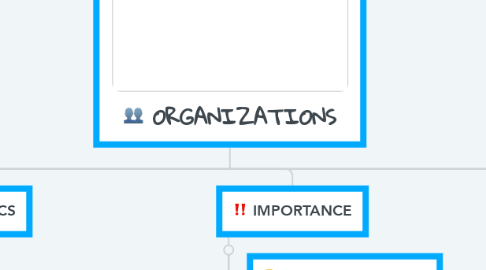
1. DEFINITION
1.1. Rational System
1.1.1. Highly formalized, collective system oriented to the persuit of specific goals
1.2. Natural System
1.2.1. Organizations are social systems, forged by consensus or conflict, seeking to survive
1.3. Open System
1.3.1. Organizations depend on flows of personal, resources and information from outside
1.3.1.1. Environment shapes and support organizations.
1.3.1.2. Organizations are based on cultural-cognitive elements.
2. ELEMENTS
2.1. Social actors
2.1.1. Individuals that make contributions to the organizations
2.1.2. Always search inducements
2.1.3. Demographic characteristics influence the social structure
2.1.4. Agency
2.1.4.1. The ability of an actor to have some effect on the world
2.2. Goals
2.2.1. Are conceived as conceptions of desired ends
2.2.2. Involve cultural-cognitive and normative elements
2.3. Technology
2.3.1. Organizations own technology for doing works
2.3.2. Clasification
2.3.2.1. Organizations can process poeple
2.3.2.1.1. Knowledge and services
2.3.2.2. Organizations that process material inputs
2.3.2.2.1. Hardware, machines
2.4. Environment
2.4.1. Organizations are determined by environmental factors
2.4.2. Is the principal source of the organizations
2.4.2.1. They use it for produce technology
3. IMPORTANCE
3.1. Explains social issues
3.1.1. Gender Inequality
3.1.2. The spread of a power elite
3.1.2.1. Exploitation of people
3.1.3. Rationalization of modern life
3.2. As media
3.2.1. Organizations represent extensions of ourselves
3.2.2. They are a machanisms to reach goals
3.3. As an area of study
3.3.1. Organizations contribute to understand social processes in our history
3.3.1.1. They could be analized from sociological, administrative and political perspective.
3.3.2. There are three forms of research
3.3.2.1. Basic/Academic
3.3.2.1.1. Leads to theorical arguments
3.3.2.2. Applied studies/ Nonacademic
3.3.2.2.1. Contributes to general knowledge. It uses a great variety of variables
3.3.2.2.2. Solves specifics problem
3.3.3. There are three levels of analysis
3.3.3.1. Social
3.3.3.1.1. According to the behavior
3.3.3.2. Organizational structure level
3.3.3.2.1. Focuses on processes and subdivisions
3.3.3.3. Ecological
3.3.3.3.1. Examine the relation between organizations and environment
4. CAPACITIES
4.1. Durability
4.1.1. They are designed to persist over time
4.1.2. Does not neccesarily imply effectiveness
4.1.3. They are flexible to deal with problems
4.2. Reliability
4.2.1. Prevents from changing their rules and procedures
4.2.2. The use of models automatized for production procceses
4.3. Accountable
4.3.1. Is supported by legal codes (paper trail) and behavior frameworks
4.3.2. It allows to ensure that rules are being followed
5. HISTORY
5.1. Before Christ
5.1.1. Organizations were present in older civilizations
5.1.1.1. Chinese, Greek and Indian
5.2. After Christ/ Modern society
5.2.1. Emerged during the 19th century in Europe and America
5.2.1.1. As a result of the Industrial Revolution
5.2.2. In the USA were formalized in 1997
5.2.2.1. Census Bureau launched a Standard Statistical Establishment List for All Businesses
5.2.3. Nowadays their development has been gradual and unnoticed
5.2.4. The spread of public bureaucracies and the displacement of the family business have constituted a new revolution.
6. SOCIAL STRUCTURES
6.1. Characteristics
6.1.1. They are neither independent nor identical
6.1.2. Do not connote social harmony
6.1.2.1. Conflicts have shaped the social structure
6.1.3. Operate only in specific spatial location and over time.
6.2. Clasification
6.2.1. According to the ways they can be analized
6.2.1.1. Normative structure
6.2.1.1.1. What ought to be
6.2.1.1.2. Is composed by values, norms and role expectations
6.2.1.2. Behavioral structure
6.2.1.2.1. Is focused on actual behavior
6.2.2. According to its formalization
6.2.2.1. Formal
6.2.2.1.1. Social positions are specified and defined independently of the personal characteristics
6.2.2.1.2. Informal
7. CHRACTERISTICS
7.1. General
7.1.1. Define objectives
7.1.2. All participants must be selected
7.1.3. All must control and coordinate liabilities and assets
7.1.4. Resources must be garnered from the environment
7.2. Divergent
7.2.1. Size
7.2.1.1. It is not associated with success, nowadays
7.2.1.2. Many corporations use restructurations for downsize their personal and increase their productivity
7.2.1.2.1. The most productive and innovate businesses are often small or intermediate in size
7.2.2. Environment
7.2.2.1. Their objectives change due to the contexts where they develop.
7.2.2.1.1. Time, customers, budget
7.2.3. Staff/personal
7.2.3.1. Many organizations look for speacialized personal
7.2.3.1.1. Others hire just workforce personal
7.2.4. Structural
7.2.4.1. Alliance forms
7.2.4.1.1. Connections between small and large size corporations to take advantage of the benefits of each other
7.2.4.2. Capital intensive
7.2.4.2.1. Their resources are placing in machinery and automated equipment
